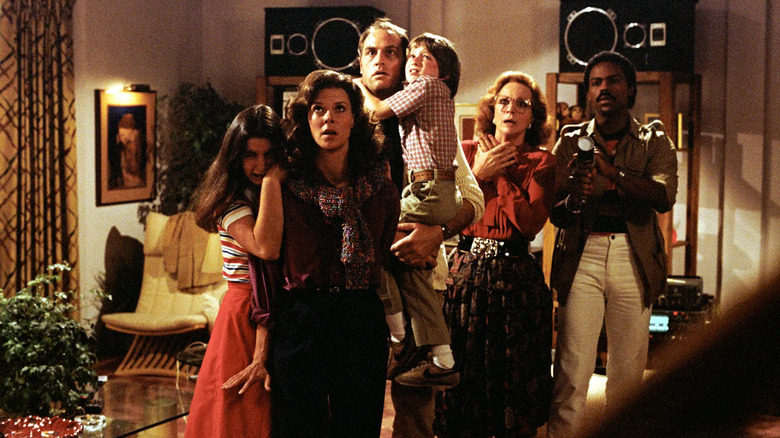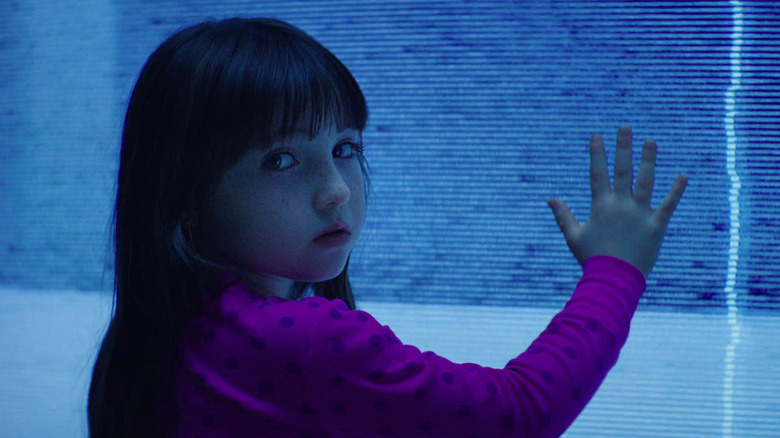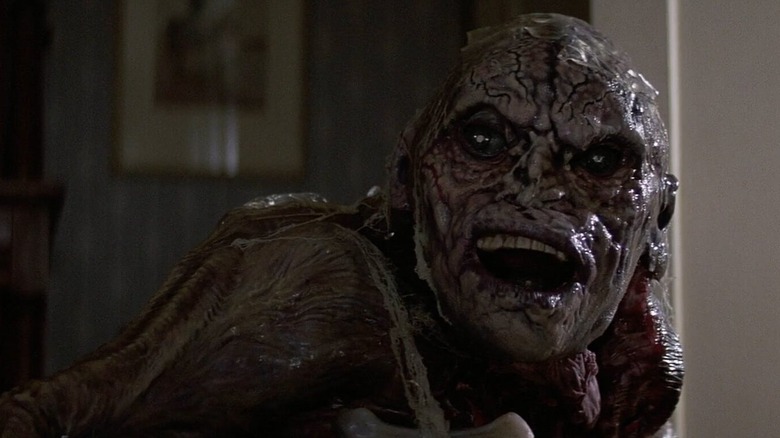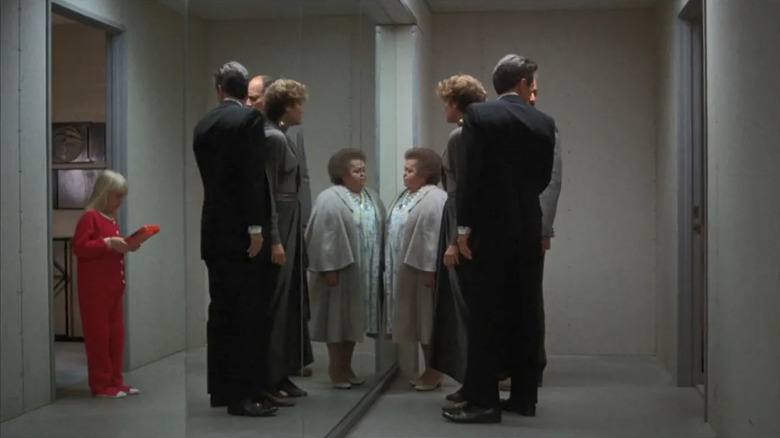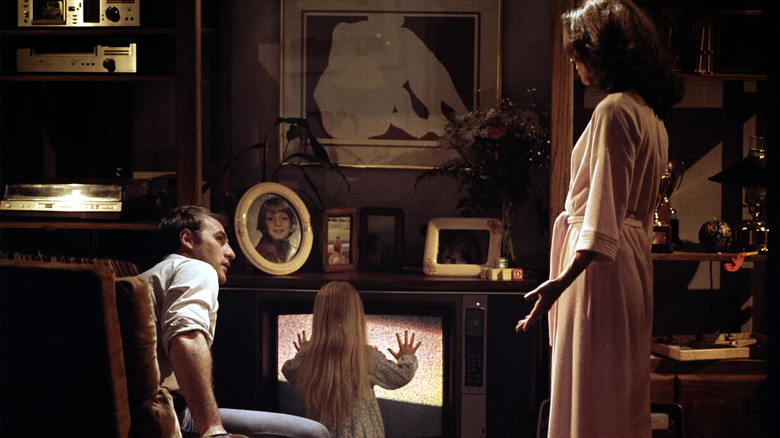The Poltergeist Movies Ranked From Worst To Best
"They're here."
With those two words, the nebulous world of the supernatural, the ominous ambiguity of the paranormal, and the deep-seated terror that is inherent in the concept of ghosts were perfectly summed up by 1982's "Poltergeist." Despite the film being over 40 years old, it still holds up as one of the most modern movies about the paranormal ever made. Sure, there had been films about ghosts and hauntings before, but many of these tended to be set in remote, antiquated locations such as spooky old mansions and abandoned homes on a hill. More than even the well-regarded visual effects, the biggest innovation of "Poltergeist" is its quintessentially American suburban setting, the inherent message being that ghosts aren't merely sequestered in places that average people would never dare go; instead, they exist right next to us.
Released during the busy summer of '82 (and just a week before producer/co-writer Steven Spielberg's box office juggernaut of that year, "E.T. The Extra-Terrestrial"), "Poltergeist" more than held its own, making $121.7 million over a $10.7 million budget. That, coupled with its massive influence on the supernatural horror film and pop culture in general, all but ensured the film would become a franchise. However, as each film underwent hardships both in front of and behind the cameras, the mounting bad luck of the series became difficult to ignore, leading to the so-called "curse" that people attributed to the films in a tabloid-like fashion.
That said, there's a far less salacious reason for the issue with making "Poltergeist" into a successful franchise: that first film is just so phenomenal, it'd be difficult in the best circumstances to try and top it. It's certainly not for lack of trying, though, and each "Poltergeist" sequel, for their various faults, contains thrilling, horrifying, and innovative moments that have kept the franchise — not to mention our collective fear of ghosts — alive.
4. Poltergeist (2015)
At the time, the wave of remakes of horror classics (soft launched with 1998's "Psycho" and kickstarted by 2003's "The Texas Chainsaw Massacre") was looked upon by die-hard horror fans as dull at best, abominable at worst. Coming at the tail end of that trend, 2015's "Poltergeist" was done no favors by a lackluster marketing campaign (which bizarrely attempted to cash in on one of the most indelible images from the 1982 film while making newcomers think it may be a movie about a killer clown) and rancid word-of-mouth. The resulting film is indeed a little frustratingly uneven; there are returning bits of plot and iconography from the original that ring hollow in context, and some newly added elements aren't fleshed out enough to make an impact (especially the concept of the haunted house's previous owner putting speakers within every wall of the home).
With the benefit of hindsight, however, a lot of these vilified horror remakes are being reconsidered, and on second look, "Poltergeist" does have some great stuff going for it. The involvement of producers Sam Raimi and Rob Tapert lends the film some genre cred, and screenwriter David Lindsay-Abaire updates the original's Reagan-era commentary with a clever inclusion of the then-recent subprime mortgage crisis being the reason for parents Eric (Sam Rockwell) and Amy (Rosemarie DeWitt) willingly buying a house made affordable due to it being built over an old cemetery. The inclusion of more screens that the ghosts can do their spooking through (thanks, smart devices!) is fun, as is the bickering between divorced ghost hunters Brooke (Jane Adams) and Carrigan (Jared Harris), which is part Warrens of "The Conjuring" and part Nick and Nora of "The Thin Man."
The biggest reason to see "Poltergeist" 2015 is for the contributions of director Gil Kenan, who follows up the visual inventiveness of "Monster House" with some fantastic set pieces, including Cousin Greg from "Succession" (Nicholas Braun) being menaced by a possessed power drill. And hey, the end credits cover of The Cramps' "TV Set" by Spoon is an all-time banger, too.
3. Poltergeist II: The Other Side (1986)
Who are the real stars of "Poltergeist": the Freeling family, or the ghosts themselves? Was the incident at Cuesta Verde a one-off instance of foolish corporate oversight, or was there something far older and more sinister afoot? What exactly did that supernatural realm that Carol Anne (Heather O'Rourke) was abducted into look like? These questions and more are what "Poltergeist II: The Other Side" attempts to answer, and not all of the answers end up being wholly satisfying.
The co-writers of the original film, Michael Grais and Mark Victor, try taking the series in a much more metaphysical and spiritual direction than Spielberg or Tobe Hooper had done, and that subtle shift in focus may have panned out had there not been some behind-the-scenes issues that cropped up. For one, the (unavoidable and tragic) absence of Dominique Dunne as the Freeling's eldest daughter is sorely felt in a movie that wants to use the unity of the family as their biggest asset against Evil. For another, director Brian Gibson had trouble juggling the various visual effects sequences, and the film's post-production saw the final cut shrink from 114 to 90 minutes, have key sequences shuffled around, and — most harmfully — resulted in the climactic sequence where the Freelings visit "the Other Side" be reworked and revised several times, leaving it a confused and unintentionally hokey finale.
Fortunately, some incredible images, moments, and performances in the film help it overcome its other woes. Chief among them is Julian Beck as Reverend Henry Kane (the persona referred to as The Beast in the first film) who makes Kane one of the most terrifying screen villains ever. JoBeth Williams and Craig T. Nelson have a lot more to chew on here as the Freelings' marriage is attacked by Kane (especially in the guise of the infamous Tequila worm creature designed by none other than H.R. "Alien" Giger), composer Jerry Goldsmith delivers another fabulous score, and O'Rourke's Carol Anne gets to continue the series' "Twilight Zone" homage, this time conversing with ghosts via her toy telephone a la "Long Distance Call."
2. Poltergeist III (1988)
Let's get the tragedy out of the way: "Poltergeist III" suffers from the loss of not one, but two of its leading actors. The first, Julian Beck, succumbed to illness shortly before the release of "Poltergeist II," and even though he obviously couldn't return for "III," the appearance of Kane is designed to resemble him enough that Beck is credited in the final film. The second, Heather O'Rourke, passed away due to illness while the movie was in post-production, shortly before director and co-writer Gary Sherman was about to shoot a newly developed ending for the film.
As such, "Poltergeist III" suffers from similar issues that plagued "Poltergeist II"; there's confusion surrounding the series' mythology, with this Reverend Kane (Nathan Davis, with voice by Corey Burton) having motivations contradictory to his character in the second film, and the supernatural activity is now based more in surreal, "A Nightmare on Elm Street"-esque rules (or lack thereof), which stand in stark contrast to Spielberg/Grais/Victor's more rigid parapsychology from the original. The fact that Nelson and Williams declined to return, leaving Carol Anne, Kane, and the medium Tangina (Zelda Rubinstein) as the only returning characters, means that "Poltergeist III," as a sequel, feels almost as abandoned as Carol Anne herself.
However, just as Carol Anne learns to draw spiritual strength from her blended family of Aunt Pat (Nancy Allen), Uncle Bruce (Tom Skerritt), and cousin Donna (Lara Flynn Boyle), "Poltergeist III" finds its own footing by not being slavish to Hooper's film, instead blazing its own tantalizingly eerie and thrillingly magic path. "Magic" is the key word there: in seeking to give his film an aesthetic separate from the visual effects gumbo that "The Other Side" became, Sherman has all the special effects for the movie be performed in-camera, utilizing various tricks of perspective, mirrors, lighting, and so on. As a result, "Poltergeist III" has an uncanny tangible quality, making its tale of a Chicago high-rise beset by Kane and his spectral helpers feel that much more disturbingly real. While Sherman and co-writer Brian Taggart leave the Freelings and much of Grais and Victor's mythos behind, they do right by the franchise's theme of family as well as its incisive social commentary, turning the high-rise into a microcosm of chilly (literally) late-'80s corporate culture. One of the last purely analog genre films ever made (and influential for that reason), "Poltergeist III" presents a compelling journey through the looking glass.
1. Poltergeist (1982)
What is it that gives "Poltergeist" its incredible, lasting power? For one thing, controversy; while I'm here to tell you that "Poltergeist" is, as its opening title card says, "A Tobe Hooper Film," there's certainly been enough debate on that over the years, and you can go spend hours wading through such discussion yourself. For another, that controversy has allowed an air of mystery to remain over the movie. In an age where so many classics (particularly genre films) have had every aspect of their production exposed and discussed multiple times over, there are still behind-the-scenes corners of "Poltergeist" that have barely been illuminated, and even though this is ostensibly for political reasons, it allows the film to feel somehow forbidden, its PG-rating and child stars combined with its moments of graphic violence and use of real skeletons just several instances of the movie itself being eerily transgressive.
Perhaps the real answer is because "Poltergeist" so successfully combines the tones of two powerful filmmakers — Spielberg and Hooper — in a way that makes the movie as spooky, awe-inspiring, and uncomfortable as it apparently was designed to. There are numerous moments of the Freelings becoming enamored with the discovery that their house is not "clean," and those Spielberg-face moments are bolstered by instances of their appliances, chairs, and whatnot moving around by themselves in a fashion highly akin to scenes in Spielberg's "Close Encounters." Meanwhile, Hooper and Goldsmith choose to start the film with "The Star-Spangled Banner," indicating the movie's real thematic target and not just its setting, and the story of the developers of Cuesta Verde (as Nelson's Steven Freeling histrionically sums up) moving the headstones and leaving the bodies of an ancient cemetery to exploit the land is as good an analogy for the founding of the United States as anything.
Put simply, absolutely everything in "Poltergeist" works, from the core of the story being borrowed from Richard Matheson's "Little Girl Lost" episode of "The Twilight Zone" to Industrial Light and Magic's visual effects paying off the film's physical special effects and sound design to the production design (that staircase!), the script's basis in real-life parapsychology, and even the location shooting, with the Freeling's home looking suspiciously similar to every house that surrounds it. Maybe we don't need to worry about stumbling upon a haunted house, the film seems to say, because we're all already living in one.
